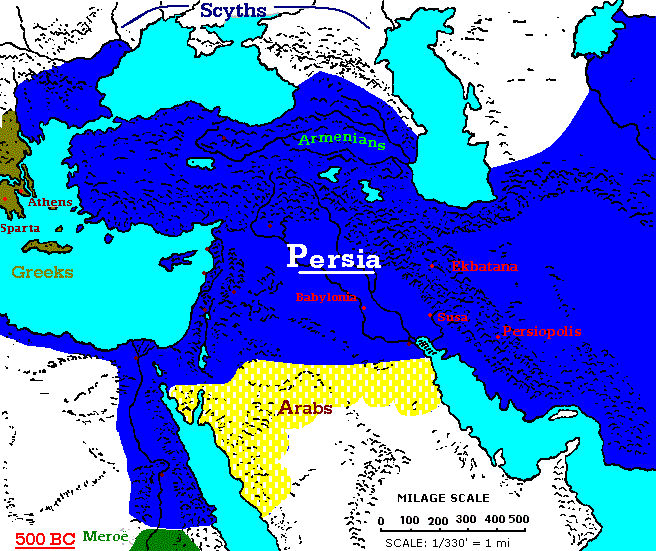The religion of Zoroastrianism began in
Persia (ancient Iran) in the fifth and
fourth centuries B.C.
2.) How did Zoroastrianism spread beyond its place of
origin?
Zoroastrianism spread beyond Persia (along with other aspects of Persian culture) after the area was conquered by Alexander the Great in 328 B.C.
3.) Briefly describe the religious experience
Zarathustra had about the age of thirty.
When Zarathustra was about thirty years old, the
Angle “Good Thought” appeared to him, and brought him before Ahura Mazda, (the “Great Lord”), in the
form of a disembodied soul. He recognized Ahura
Mazda as the one true god. After this revelation, he preached “the radical
message of monotheism to his polytheistic society.”
4.) Name the sacred text of Zoroastrianism. What is the
oldest material in this text and who wrote it?
The Avesta
is the oldest text of Zoroastrianism. The oldest material is the Gathas. They are the first seventeen hymns
that he wrote.
5.) Summarize the characteristics and actions associated
with Ahura Mazda.
6.) What is ethical dualism?
Ethical dualism
is “the belief in universal forces of good and evil”. It is Zoroastrianism’s
most distinctive feature.
7.) What is the Lie and how does it relate to Ahura
Mazda?
The Lie
is an “evil, cosmic force”. The Lie opposes Ahura Mazda, the eternal and
universal goodness in the universe.
8.) What must humans choose between in the Zoroastrian
cosmic scheme?
Humans must choose between the Truth and the Lie.
Just as Ahura Mazda’s two children had to choose between the truth and the lie,
one chose Truth and one chose the Lie, all human beings must follow that same path
of choices.
9.) Summarize Zarathustra’s understanding of human
destiny.
Zarathustra believed that after death,
an individual would undergo judgment. This judgment would mean for the
individual to cross “the Bridge of the Separator” (a bridge that spans over an
abyss of “horrible torment”(similar to the River Styx in Greek mythology) , but
eventually leads to paradise), and are then the ethical records of that
specific individual are read and judged. If you have lived a good life, you are allowed to enter papadise, however, if you led an evil life, you are cast into the abyss. They also believe in "a final bodily resurrection of everyone, good and evil alike".
10.) What are the general ethical demands of
traditional Zoroastrian life?
The general ethical demands of traditional Zoroastrian life are "centered on agriculture", and include living a simple life, always telling the truth and doing what is right.
11.) Who are the Parsis, and where do most of them
live today?
The Parasis are those who still practice Zoroastrianism today and "combine a wide variety of features from the Zoroastrian tradition". Today, most Zoroastrians live in India.
The Illiad and the Odyssey, by Homer, are commonly regarded as having been the Bible of Ancient Greeks.
13.) Explain the meaning of this sentence: “The gods of the Olympic Pantheon are arihropomorphic.”:
13.) Explain the meaning of this sentence: “The gods of the Olympic Pantheon are arihropomorphic.”:
As arihropomorthic is a greek word that means "of human form", this statement means that the Greek gods often behave more like humans, rather than like gods.
14.) What was Aeschylus’s main contribution to the
understanding of the gods of the Olympic Pantheon? Give an example.
15.) What is an oracle? What was the most famous oracle of
Ancient Greece and why was it consulted?
An oracle is "a sancuary favored by a particular god, who communicated in some manner to those who visited the site. (The word oracle refers to the god's message itself, or the medium through which it is communicated.)". The most famous oracle of Ancient Greece was the
Oracle at Delphi. It was consulted when Greeks "sought the wisdom of [the Greek god], Apollo."
16.) Briefly identify the three basic aspects of the
mystery religions.
1. "Individuals had to choose to become initiates" (they went through a form of initiation ritual)
2. "Initiates experienced a personal encounter with the deity."
3. "Initiates gained spiritual renewal through participation in the religion, and (as with most mystery religions), hope for a better afterlife."
1. "Individuals had to choose to become initiates" (they went through a form of initiation ritual)
2. "Initiates experienced a personal encounter with the deity."
3. "Initiates gained spiritual renewal through participation in the religion, and (as with most mystery religions), hope for a better afterlife."
17.) What mystery religion honored Demeter and
Persephone?
The myster religion par excellence honored Demeter, the goddess of grain and her daughter, Persephone.
The myster religion par excellence honored Demeter, the goddess of grain and her daughter, Persephone.
18.) What is the god Dionysus associated with and how is
he depicted in Greek art?
The god Dionysus is associated with wine and grapes,
and in greek art is depicted drinking wine, and "living prosperously".
19.) Name the goal of the ascetic practices of the
orphics.
20.) What is Plato’s theory of knowledge?
21.) What is Platonic dualism?
22.) Why did Jesus seem to have much in common with the
ancient Asclepius?
23.) What were “numina”
and what sort of things were they thought to inhabit?
24.) Who was the most powerful roman deity?
Zeus was the most powerful roman deity (as similar in Greek mythology).
25.) Identify the six planets of our solar system that
were named after Roman deities.
2.Venus
3.Mars
4.Jupiter
5.Saturn
6.Neptune
26.) Why did the Roman state consider it essential to
maintain official worship practices?
27.) Which mystery religions were the main rivals of Christianity
in the later Roman Empire?
28.) Briefly summarize the Egyptian myth of Isis and
Osiris.
29.) Briefly describe the sort of emperor worship
encourages by Augustus.
30.) Why did Christians and Roman rulers clash over
emperor worship?

